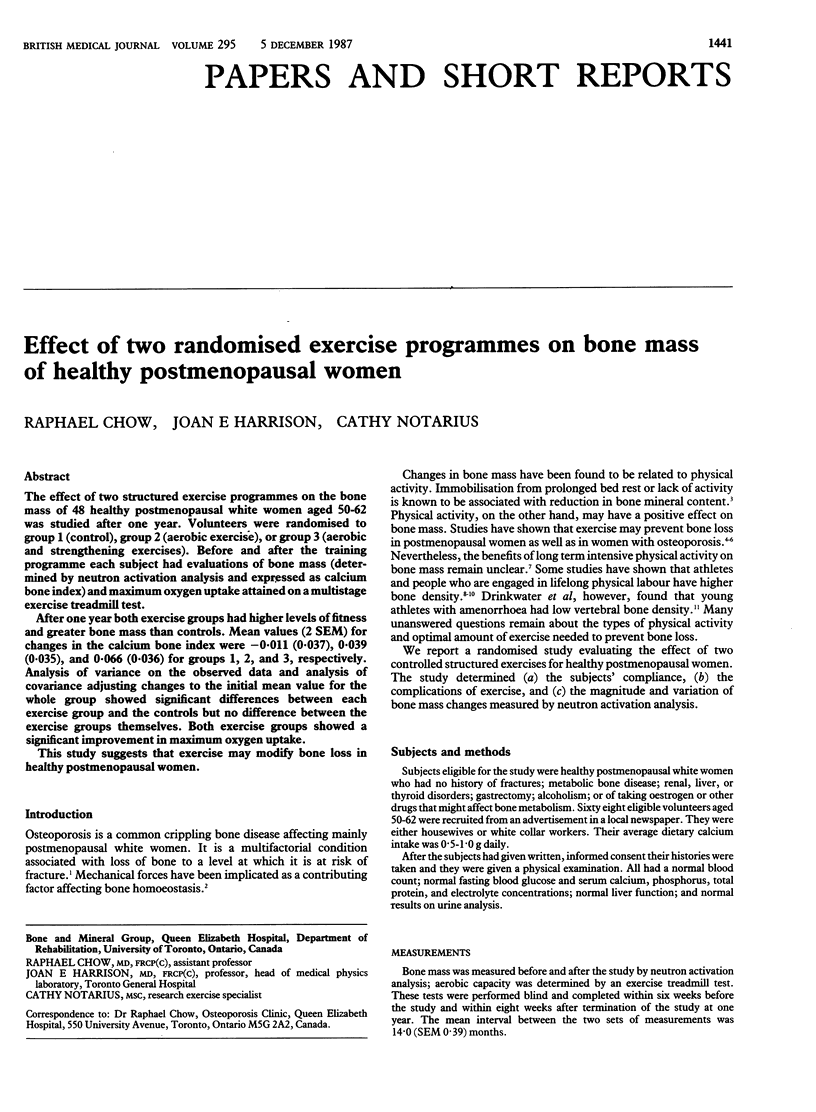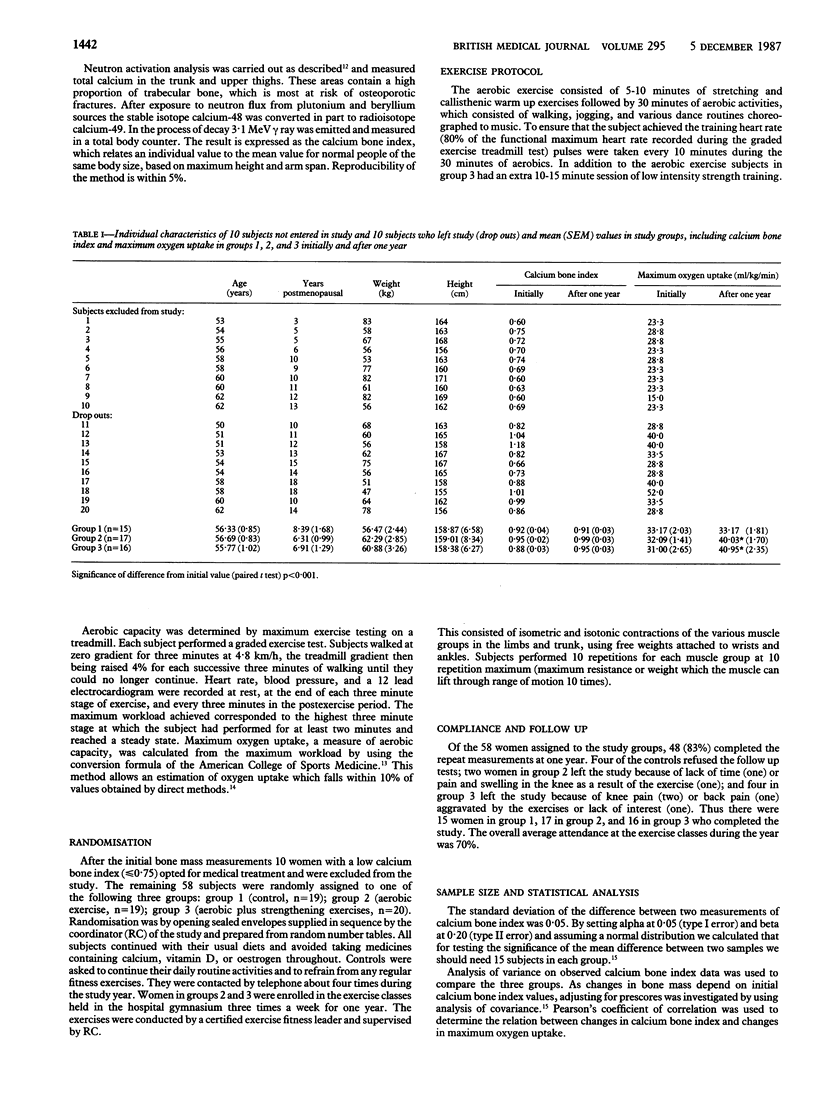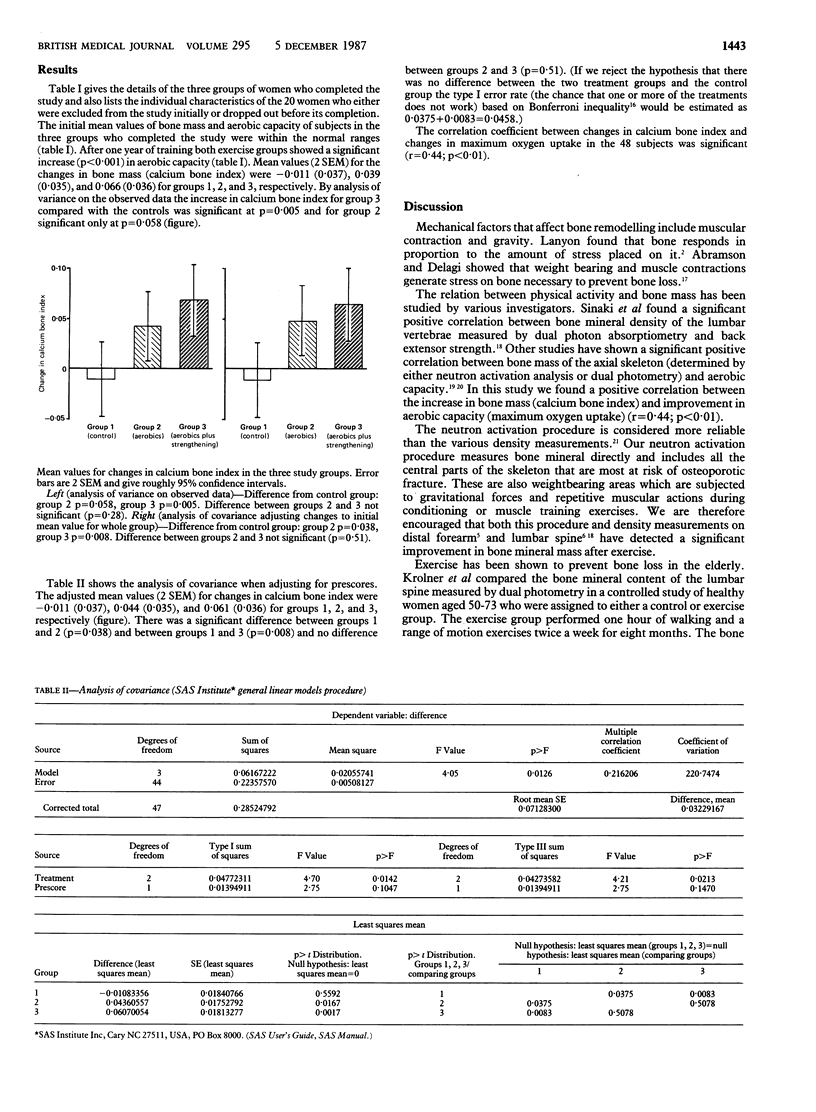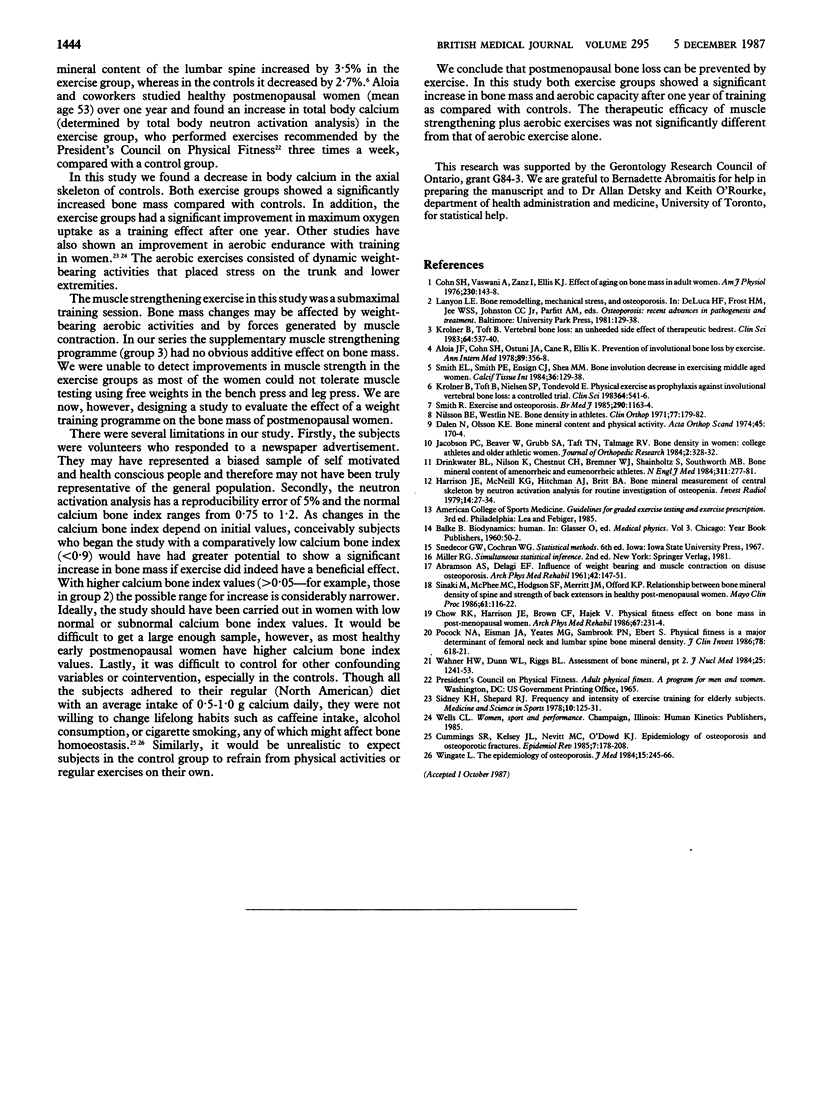Abstract
The effect of two structured exercise programmes on the bone mass of 48 healthy postmenopausal white women aged 50-62 was studied after one year. Volunteers were randomised to group 1 (control), group 2 (aerobic exercise), or group 3 (aerobic and strengthening exercises). Before and after the training programme each subject had evaluations of bone mass (determined by neutron activation analysis and expressed as calcium bone index) and maximum oxygen uptake attained on a multistage exercise treadmill test. After one year both exercise groups had higher levels of fitness and greater bone mass than controls. Mean values (2 SEM) for changes in the calcium bone index were -0.011 (0.037), 0.039 (0.035), and 0.066 (0.036) for groups 1, 2, and 3, respectively. Analysis of variance on the observed data and analysis of covariance adjusting changes to the initial mean value for the whole group showed significant differences between each exercise group and the controls but no difference between the exercise groups themselves. Both exercise groups showed a significant improvement in maximum oxygen uptake. This study suggests that exercise may modify bone loss in healthy postmenopausal women.
Full text
PDF



Selected References
These references are in PubMed. This may not be the complete list of references from this article.
- Aloia J. F., Cohn S. H., Ostuni J. A., Cane R., Ellis K. Prevention of involutional bone loss by exercise. Ann Intern Med. 1978 Sep;89(3):356–358. doi: 10.7326/0003-4819-89-3-356. [DOI] [PubMed] [Google Scholar]
- Celio M. R., Norman A. W., Heizmann C. W. Vitamin-D-dependent calcium-binding-protein and parvalbumin occur in bones and teeth. Calcif Tissue Int. 1984 Jan;36(1):129–130. doi: 10.1007/BF02405306. [DOI] [PubMed] [Google Scholar]
- Chow R. K., Harrison J. E., Brown C. F., Hajek V. Physical fitness effect on bone mass in postmenopausal women. Arch Phys Med Rehabil. 1986 Apr;67(4):231–234. [PubMed] [Google Scholar]
- Cohn S. H., Vaswani A., Zanzi I., Ellis K. J. Effect of aging on bone mass in adult women. Am J Physiol. 1976 Jan;230(1):143–148. doi: 10.1152/ajplegacy.1976.230.1.143. [DOI] [PubMed] [Google Scholar]
- Cummings S. R., Kelsey J. L., Nevitt M. C., O'Dowd K. J. Epidemiology of osteoporosis and osteoporotic fractures. Epidemiol Rev. 1985;7:178–208. doi: 10.1093/oxfordjournals.epirev.a036281. [DOI] [PubMed] [Google Scholar]
- Dalén N., Olsson K. E. Bone mineral content and physical activity. Acta Orthop Scand. 1974;45(2):170–174. doi: 10.3109/17453677408989136. [DOI] [PubMed] [Google Scholar]
- Drinkwater B. L., Nilson K., Chesnut C. H., 3rd, Bremner W. J., Shainholtz S., Southworth M. B. Bone mineral content of amenorrheic and eumenorrheic athletes. N Engl J Med. 1984 Aug 2;311(5):277–281. doi: 10.1056/NEJM198408023110501. [DOI] [PubMed] [Google Scholar]
- Harrison J. E., McNeill K. G., Hitchman A. J., Britt B. A. Bone mineral measurements of the central skeleton by in vivo neutron activation analysis for routine investigation os osteopenia. Invest Radiol. 1979 Jan-Feb;14(1):27–34. doi: 10.1097/00004424-197901000-00006. [DOI] [PubMed] [Google Scholar]
- Jacobson P. C., Beaver W., Grubb S. A., Taft T. N., Talmage R. V. Bone density in women: college athletes and older athletic women. J Orthop Res. 1984;2(4):328–332. doi: 10.1002/jor.1100020404. [DOI] [PubMed] [Google Scholar]
- Krølner B., Toft B. Vertebral bone loss: an unheeded side effect of therapeutic bed rest. Clin Sci (Lond) 1983 May;64(5):537–540. doi: 10.1042/cs0640537. [DOI] [PubMed] [Google Scholar]
- Nilsson B. E., Westlin N. E. Bone density in athletes. Clin Orthop Relat Res. 1971;77:179–182. [PubMed] [Google Scholar]
- Pocock N. A., Eisman J. A., Yeates M. G., Sambrook P. N., Eberl S. Physical fitness is a major determinant of femoral neck and lumbar spine bone mineral density. J Clin Invest. 1986 Sep;78(3):618–621. doi: 10.1172/JCI112618. [DOI] [PMC free article] [PubMed] [Google Scholar]
- Sidney K. H., Shephard R. J. Frequency and intensity of exercise training for elderly subjects. Med Sci Sports. 1978 Summer;10(2):125–131. [PubMed] [Google Scholar]
- Sinaki M., McPhee M. C., Hodgson S. F., Merritt J. M., Offord K. P. Relationship between bone mineral density of spine and strength of back extensors in healthy postmenopausal women. Mayo Clin Proc. 1986 Feb;61(2):116–122. doi: 10.1016/s0025-6196(12)65197-0. [DOI] [PubMed] [Google Scholar]
- Smith R. Exercise and osteoporosis. Br Med J (Clin Res Ed) 1985 Apr 20;290(6476):1163–1164. doi: 10.1136/bmj.290.6476.1163. [DOI] [PMC free article] [PubMed] [Google Scholar]
- Wahner H. W., Dunn W. L., Riggs B. L. Assessment of bone mineral. Part 2. J Nucl Med. 1984 Nov;25(11):1241–1253. [PubMed] [Google Scholar]
- Wingate L. The epidemiology of osteoporosis. J Med. 1984;15(4):245–266. [PubMed] [Google Scholar]


